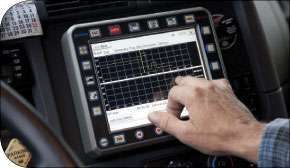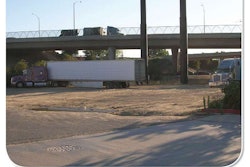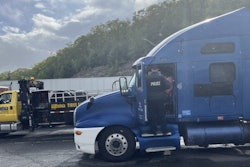Apnea proposals could disqualify drivers
Sleep apnea screening would be linked with body mass index under a proposal supported by Federal Motor Carrier Safety Administration panels.
 A proposal recommend medical examiners refer to testing for obstructive sleep apnea any trucker with a body mass index of 35 or higher.
A proposal recommend medical examiners refer to testing for obstructive sleep apnea any trucker with a body mass index of 35 or higher.According to guidance supported by FMCSA’s Motor Carrier Safety Advisory Committee and Medical Review Board, medical examiners would refer for evaluation for obstructive sleep apnea any interstate commercial driver with a BMI of 35 or higher (a 6-foot, 258-pound driver has a BMI of 35).
The guidance comes on the heels of three separate sets of recommendations the agency has received in recent years with varying screening specifications, typically involving a BMI measurement between 30 and 35 and other criteria, including risk factors.
A second guidance would immediately disqualify drivers meeting any of five criteria:
• Having reported excessive daytime sleepiness.
• Having had an accident associated with falling asleep.
• Exhibiting apnea-hypopnea index (AHI) scores of 20 or greater, until they’ve had effective treatment.
• Having had surgery to correct apnea and awaiting post-operative evaluation.
• Individuals who have been found to be effectively noncompliant with their treatment.
Both short-term guidances are intended as stop-gaps until further new rulemaking officially codifies sleep disorders into the regulations, with a draft to emerge from a MCSAC and MRB joint subcommittee as early as February.

Medical experts began making a case for the correlation between drivers with moderate to severe sleep apnea and increased crash risk during a Dec. 7 FMCSA meeting.
Todd Spencer, Owner-Operator Independent Drivers Association executive vice president, noting the statistics on risk factors for apnea among commercial drivers, asked, “If these staggering numbers have some real live applications, why don’t highways all over America look like war zones today?”
Charles A. Czeisler, director of Harvard Medical’s Division of Sleep Medicine, argued that “it is actually a war zone out there.” He said 20 percent of all crashes (not just truck-related) are related to drowsy driving, and that two million drivers a week in the U.S. nod off at the wheel. With fatalities related to drowsy driving occurring once every 70 minutes on average, “that’s equivalent to two 9/11 events every year,” he said.
The proposed guidance would be, ultimately, put up for public comment, said FMCSA’s Larry Minor.
— Todd Dills
SHORT HAULS
BLUETOOTH RADIO and stereo systems are now standard in all Volvo VN and VHD models. The package comes with a radio unit and overhead-mounted microphone, and audio is delivered via the truck’s speaker system. Call information is displayed behind the steering wheel.
MAINE CARRIER Bisson Transportation closed its long-haul operation because it was unable to recruit the additional owner-operators it needed to be “reasonably profitable,” said President Bob Cooper.
A&E CHANNEL’S Shipping Wars reality-TV series follows six independent owner-operators pulling freight secured via the uShip.com online freight marketplace as they battle to gain the most net revenue. The 10-episode half-hour series is set to premiere Jan. 10, at 9 and 9:30 p.m. EST and PST with back-to-back episodes.
FOR-HIRE TRUCKING added 3,600 new payroll employees in November, according to preliminary numbers from the Bureau of Labor Statistics. Compared with November 2010, trucking employment is up by 33,800 jobs, or 2.7 percent. The number of trucking jobs — 1.29 million — remains 163,400 below peak employment in January 2007.
Cell phone ban began Jan. 3
A final rule that bars commercial drivers from operating handheld cell phones while driving took effect Jan. 3. Using hands-free phones is still allowed.
The new rule will permit truck and bus drivers to use handheld cells after they have stopped their vehicles.
Violators will face a maximum civil penalty of $2,750 for each offense. CDL holders will be disqualified from operating a commercial motor vehicle for multiple offenses and states will suspend CDLs after two or more serious traffic violations.
Truck and bus companies that allow drivers to use hand-held cell phones while driving will face a maximum penalty of $11,000.
Federal Motor Carrier Safety Administration research shows using a handheld cell phone while driving requires “risky steps.” Dialing a hand-held cell phone raises the crash risk for commercial drivers six-fold.
Last year, the agency issued a final rule banning commercial drivers from text messaging while operating trucks or buses.
The Owner-Operator Independent Drivers Association had asked the agency why other risky activities contributing to driver distraction were not addressed in the rule. FMCSA noted it is considering an advance notice of proposed rulemaking to seek public comment on the extent further regulatory action is needed to address the distraction of other in-cab electronic devices. However, the agency disagreed with OOIDA’s assertion that the new regulation constituted a “search” or “seizure” to which the Fourth Amendment protection applies.
The American Trucking Associations has supported the handheld ban, while strongly opposing a ban on hands-free devices. ATA supports barring texting and handheld cell use for all motorists to reduce distracted driving.
— Jill Dunn
Senate bill would mandate EOBRs
The Senate Commerce, Science and Transportation committee approved legislation Dec. 14 that would require truck electronic on-board recorders and authorize the federal transportation department to assess driver safety fitness. The bill, S.1950, moves on to the full Senate.
 A senate bill would ratchet up federal regulation of trucking by mandating an electronic onboard recorder for every truck.
A senate bill would ratchet up federal regulation of trucking by mandating an electronic onboard recorder for every truck.Sen. Frank Lautenburg, (D-N.J.), introduced the Commercial Motor Vehicle Safety Enhancement Act that reauthorizes the Federal Motor Carrier Safety Administration.
In August, the U.S. Court of Appeals for the Seventh Circuit ruled against the FMCSA’s requirement to mandate recorders. The court agreed with the Owner-Operator Independent Drivers Association’s argument that the agency’s rule lacked sufficient protection against carriers to prevent companies from harassing drivers, such as demanding they work when fatigued.
The legislation would require applicants for operating authority pass a safety proficiency examination and submit a safety management plan, according to information from Lautenberg, also chair of the Commerce Subcommittee on Surface Transportation.
Additionally, the bill would:
• Increase the FMCSA’s ability to revoke carriers’ operating authority and require new operators applying for authority to disclose all relationships with other carriers during the past five years.
• Directs the DOT to support implementation of the Compliance, Safety and Accountability program.
• Requires study of the safety and infrastructure effects of increasing truck size and weight limits.
Democrat Sens. Jay Rockefeller of West Virginia, Senate Commerce Committee chairman, and Mark Pryor of Arkansas, Consumer Protection Subcommittee chairman, co-sponsored the bill. Advocates for Highway and Auto Safety and Parents Against Tired Truckers support the bill.
— Jill Dunn
Health certificate change starts Jan. 30
Truckers must keep paper copies of their medical examiner’s certificate with them while driving for another two years beginning Jan. 30, according to a federal final rule.
The Federal Motor Carrier Safety Administration’s rule extends that mandate for interstate CDL holders until Jan. 30, 2014. It also will continue requiring carriers keep paper copies of their drivers’ certificates until then.
The final rule is a follow-up to the agency’s notice of proposed rulemaking, issued last June, which proposed amending a 2008 final rule.
That 2008 final rule required CDL holders subject to federal physical qualification to provide an original or copy of their medical examiner’s certificate to their state driver’s licensing agency. State agencies must post the medical certification information in the Commercial Driver’s License Information System, a federal database.
After the 2008 rule, several states told the FMCSA their offices lacked the capacity to comply by the rule’s Jan. 30 deadline. The agency extended the paper copy requirement for interstate CDL holders and carriers two years to provide sufficient overlap for state agencies.
However, FMCSA did not extend the deadline for state agencies. Beginning Jan. 30, drivers applying for or renewing CDLs under the non-excepted interstate category will have to self-certify and provide the certificate or a copy to the state licensing agency. All drivers affected by the rule will have to comply by Jan. 30, 2014.
More information on the final rule, FMCSA-1997–2210, is available at www.regulations.gov.
— Jill Dunn
SHORT HAULS
A TRUCKER pled guilty to seven counts of arson at truck stops in six states, a crime authorities say he usually committed on occupied parked trucks. Steven Oakley Price, 41, of Licking, Mo., pleaded guilty Dec. 1 in the U. S. District Court for Missouri’s western district. If the court accepts Price’s plea agreement, he will serve an eight-year federal prison term without parole. Price inserted fuel-soaked clothing, rags or fuel filters into the wheel wells of tractor-trailers. No serious injuries occurred, according to the district’s U.S. attorney.
Third Mexican carrier completes audit
While members of Congress and a federal court continue weighing issues concerning the cross-border trucking program with Mexico, a third Mexican carrier has completed its Pre-Authority Screening Audit.
A Nov. 29 Federal Register notice announced Moises Alvarez Perez, doing business as Distribuidora Marina El Pescador, of Tijuana, Baja California, completed its pre-authority screening audit.
So far, the Federal Motor Carrier Safety Administration has granted operating authority to one of three Mexico-based carriers that cleared the PASA. FMCSA conducts these audits on Mexican carrier applicants to verify program compliance.
Transportes Olympic of Apodaca, Nuevo León, made the first crossing under the program on Oct. 21.
FMCSA’s Federal Register Oct. 14 notice responded to public comment on the PASA of Grupo Behr of Apodaca, Nuevo León. The agency had planned to grant authority, but instead announced it would extend review of the carrier to investigate questions raised by groups commenting on its PASA results.
On Oct. 31, Sen. Jay Rockefeller, (D-W.Va.), transportation committee chairman, expressed concern about “lax oversight” of the program in a letter to Transportation Secretary Ray LaHood.
The U.S. Court of Appeals for the D.C. Circuit issued the same briefing schedule for two lawsuits seeking to block the FMCSA program, but has not combined the cases. The Teamsters union, Public Citizen and Sierra Club petitioned the court Nov. 15 and the Owner-Operator Independent Drivers Association filed suit July 6.
The petitioners’ briefs and appendices were due Dec. 21, the FMCSA’s brief on Feb. 1 and the petitioners’ reply brief Feb. 22.
— Jill Dunn
SHORT HAULS
NET NEW TRAILER orders in October rose to the highest level since May, ACT Research said. Seasonally adjusted, October’s backlog rose 1.5 percent month over month. Also, reported sales of used Classes 3-8 trucks declined in October, after rising in September. Scarce inventory and sustained demand may be the cause, the firm said.
Truck-related deaths rose in 2010
While overall highway deaths in 2010 were at the lowest level since 1949, truck-related fatalities increased for the first time in three years, the U.S. Transportation Department announced.
Truck-involved deaths rose 8.7 percent in 2010 from 2009 to 3,675, including drivers and passengers. Truck driver fatalities increased 6 percent to 529, with 64 percent of those deaths involving single-vehicle crashes, the National Highway Traffic Safety Administration said. The number of truck drivers killed in multi-vehicle crashes also increased 16 percent.
Injuries from truck-related crashes rose 12 percent in 2010 from the previous year.
The American Trucking Associations pointed out that from 1999 through 2009, truck-related fatalities declined 35 percent while injuries dropped 48 percent.
The highway death count of 32,885 occurred even as American drivers traveled nearly 46 billion more miles during the year, an increase of 1.6 percent over 2009. The fatality rate of 1.10 deaths per 100 million vehicle miles traveled in 2010 was the lowest on record.
Fatalities declined in most categories in 2010. New data also show an estimated 3,092 fatalities in distraction-affected crashes in 2010.
— Staff reports
SHORT HAULS
FREIGHT HAULING as measured by the American Trucking Associations’ seasonally adjusted For-Hire Truck Tonnage Index increased 0.5 percent in October from September. Compared with October 2010, adjusted tonnage was up 5.7 percent.
SPOT MARKET FREIGHT measured by TransCore’s North American Freight Index increased 39 percent in October compared with October 2010. This was the highest year-over-year volume since the aftermath of Hurricane Katrina that drove spot market demand to record levels in 2005. Compared with September, spot market freight volume slipped 3.7 percent, reflecting normal seasonality.
SURFACE TRADE between the United States and Canada and Mexico increased 14 percent in September from a year ago to $77.7 billion, according to the U.S. Department of Transportation.
Feds change distracted driving measurement
The National Highway Traffic Safety Administration Dec. 8 unveiled a new measure of fatalities related to distracted driving called “distraction-affected crashes.”
It was introduced for 2010 as part of a broader effort by the agency to refine its data collection to get better information about the role of distraction in crashes. The new measure is designed to focus more narrowly on crashes in which a driver was most likely to have been distracted.
While NHTSA’s Fatality Analysis Reporting System previously recorded a broad range of potential distractions, such as careless driving and a cell phone present in the vehicle, the new measure focuses on distractions that are most likely to affect crash involvement, such as distraction by dialing a phone or texting and distraction by an outside person or event. NHTSA’s refined methodology shows an estimated 3,092 fatalities in distraction-affected crashes in 2010.
While the explicit change in methodology means the new measure cannot be compared to the 5,474 “distraction-related” fatalities reported in 2009, other NHTSA data indicates that driver distraction continues to be a significant problem.
The agency’s nationwide survey of drivers shows that in 2009 and 2010, 5 percent of drivers could be seen talking on handheld phones.
More than three-quarters of drivers report they are willing to answer calls on all, most or some trips, a new NHTSA survey shows.
— Staff reports
SHORT HAULS
CLASS 8 truck orders in November fell 27 percent from October to about 20,400 units, ACT Research Co. said. FTR Associates said this was the first decrease in over a year.
The orders were “substantially below expectations,” said Eric Starks, FTR president, noting that November is in “typically the strong order period of the year.”
MARCUS BEAM was named the Truckload Carriers Association 2011 Highway Angel of the Year. On Aug. 8 on I-40 in North Carolina, Beam safely rescued a 6-month-old infant and a toddler from an overturned car. He is a driver for Epes Transport System of Greensboro, N.C.
LOS ANGELES PORTS on Jan. 1 will hit the final phase of the ports’ Clean Trucks Program. Beginning Jan. 1, both ports no longer will assess a Clean Truck fee on trucks with an engine year of 2006 and older, which will be banned from port marine terminals. Port officials say 98 percent of container moves at the facility are done by rigs with model year 2007 and newer engines.
HIGHWAY HAPPENINGS
MICHIGAN. The state Department of Transportation will keep open 76 of the state’s 81 rest areas this winter. Only five rest areas will be closed through April 2. Three of the closed rest areas are on I-75 and two are on U.S. 31.
MINNESOTA. The state Pollution Control Agency has a Clean Diesel grant for state-based fleets that operate primarily in the state, with a focus on 2006 and older vehicles. The $350,000 grant covers EPA/CARB-certified idle reduction and emissions reduction technologies, emission upgrades and reefer re-powers. Contact Martina Cameron at (651) 757-2259.
MISSISSIPPI. Many state and municipal officials oppose for safety reasons Congressional proposals to increase heavy truck weights to 97,000 pounds from 80,000. The American Trucking Associations and Truckload Carriers Association support the increase.
OREGON/WASHINGTON. Plans to replace the aging Interstate 5 Columbia River Crossing Bridges and build an interstate transit link have advanced. Final clearance was given to the project’s environmental review that allows Oregon and Washington to begin right-of-way acquisition and construction.
WASHINGTON. The State Patrol’s Commercial Vehicle Division is using a new tool to track compliance. The State Department of Transportation has installed automated cameras at 12 weigh stations and ports of entry that take a picture of the truck and license plate. Troopers can check the time the truck crossed the locations and compare it to the truck driver’s log book.
WEST VIRGINIA. A new online service from the state Division of Motor Vehicles makes it easier to obtain permits. Trucking companies with vehicles not registered in the state must obtain trip permits for temporary travel at the IRP/IFTA section of the department’s website. Truckers can obtain a single-trip permit by entering information and paying by credit card.
WISCONSIN. A new law allows the state Department of Transportation to issue overweight permits up to 90,000 pounds for sealed containers hauled by trucks with six or more axles. The permit would apply for produce and livestock hauls to or from a field or farm.
FTR: Hours rule delay postpones ‘crisis’
Trucking is experiencing a normal recovery from the recession and should be able to impose rate increases of 6 percent to 8 percent, including fuel, in 2012, economist Noel Perry said at an FTR Associates online seminar Dec. 8.
Trucking will not be able to restore quickly the driver and truck capacity it lost during the recession, said Perry, an FTR senior consultant.
He said the “capacity crisis” he forecast for 2011 will be pushed back to this year because of the delay in revising the hours of service rule, which was expected to be released in late December. By late 2012, the industry likely will be dealing with that impact and the effects of slow economic recovery.
Perry said only now is the industry recovering from the recession. Freight transportation is growing almost as fast as the gross domestic product and has recovered about 41 percent of tonnage hauled before the recession. He doesn’t expect a complete recovery until the end of this decade, perhaps sooner. He’s forecasting economic growth of 2.5 percent to 3 percent next year.
One growing niche is in serving those doing hydraulic fracturing for natural gas and oil wells. Trucks haul water and sand to these often remote exploration sites. “Short-term it’s a big bonanza for trucking,” Perry said.
— Max Kvidera
Arrow Trucking payout requested
Arrow Trucking’s bankruptcy trustee asked a court’s permission to distribute $2.9 million in what represents the final round of priority wage claims.
On Nov. 9, Trustee Patrick J. Malloy III asked the Tulsa, Okla., bankruptcy court to allow distribution of the claims the court previously approved and provision of his $94,773 trustee fee.
The trustee also filed a request that the court approve a settlement with Transportation Alliance Bank, which had been Arrow’s main financier. The bank would pay $850,000 to the bankruptcy estate and Malloy and the bank would dismiss all claims against each other.
If none of the parties objected and the court approved the request, the funds could have been distributed to hundreds of ex-employees in December. “It should be noted that this proposed distribution, if approved, coupled with the prior interim distribution, will represent payment in full of the priority wage claims filed and approved in this case,” Malloy wrote.
According to a previous court order, Charles Ercole, the attorney for 264 former employees, will be paid $271,334. In December 2010, Malloy distributed $1.97 million in priority wage claims to former employees.
Arrow closed without notice on Dec. 22, 2009, leaving drivers and freight stranded nationwide. The following New Year’s Day, the Federal Motor Carrier Safety Administration issued an emergency order for the carrier to get its trucks and cargo to safe locations or face penalties. A week later, the flatbed carrier petitioned for Chapter 7 bankruptcy.
— Jill Dunn













